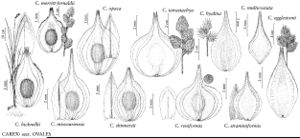Carex multicostata
Bull. Torrey Bot. Club 43: 604. 1917.
Plants densely cespitose. Culms 14–110 cm. Leaves: sheaths adaxially white-hyaline, summits U-shaped to rounded, often prolonged to 3 mm beyond collar; distal ligules (1.5–)2–3.5 (–5) mm; blades 3–4(–5) per fertile culm, 8–25 cm × (2–)3–5 mm. Inflorescences dense, brown or gold, usually ± triangular, 1.6–3 cm × 12–20 mm; proximal internode 3–5.5 mm; 2d internode 1.5–5 mm; proximal bracts scalelike or bristlelike, shorter than inflorescences. Spikes 4–6(–10), densely aggregated or, sometimes, proximal 1 distant, narrowly to broadly ovoid, (8.5–)10–12 × 6–11 mm, base rounded to attenuate, apex truncate to acute. Pistillate scales gold or light red-brown, often with pale or green midstripe, ovate to lanceolate, (3.2–)3.9–4.8 mm, longer and narrower than perignyia, margin white, 0.1–0.5 mm wide, apex acuminate. Perigynia ascending to ascending-spreading, green and white, gold, or light brown, conspicuously (8–)10–17-veined abaxially, conspicuously (0–)4–12-veined adaxially, at least 3 adaxial veins longer than achene, usually ovate or broadly ovate, plano-convex, (3.8–)4.4–5.5(–6) × (1.4–)1.8–2.5 mm, 0.5–0.8 mm thick, margin flat, including wing (0.2–)0.3–0.4(–0.5) mm wide, ciliate-serrulate distally; beak gold to dark brown at tip, flat, ± ciliate-serrulate, abaxial suture inconspicuous or with conspicuous white margin, distance from beak tip to achene 2–2.8(–3.3) mm. Achenes elliptic to broadly ovate, 1.7–2.4 × 1.1–1.7 mm, 0.4–0.6 mm thick.
Phenology: Fruiting late spring–mid summer.
Habitat: Dry soils
Elevation: 100–3500 m
Distribution

Calif., Idaho, Mont., Nev., Oreg., Utah, Wash.
Discussion
While Carex multicostata and C. specifica are usually quite distinct, the perigynia of C. multicostata are sometimes lanceolate and strongly resemble those of C. specifica. The type specimen of C. multicostata has unusually elongate inflorescences resembling those of C. specifica, rather than ± short-triangular inflorescences usually present in C. multicostata.
Selected References
None.
